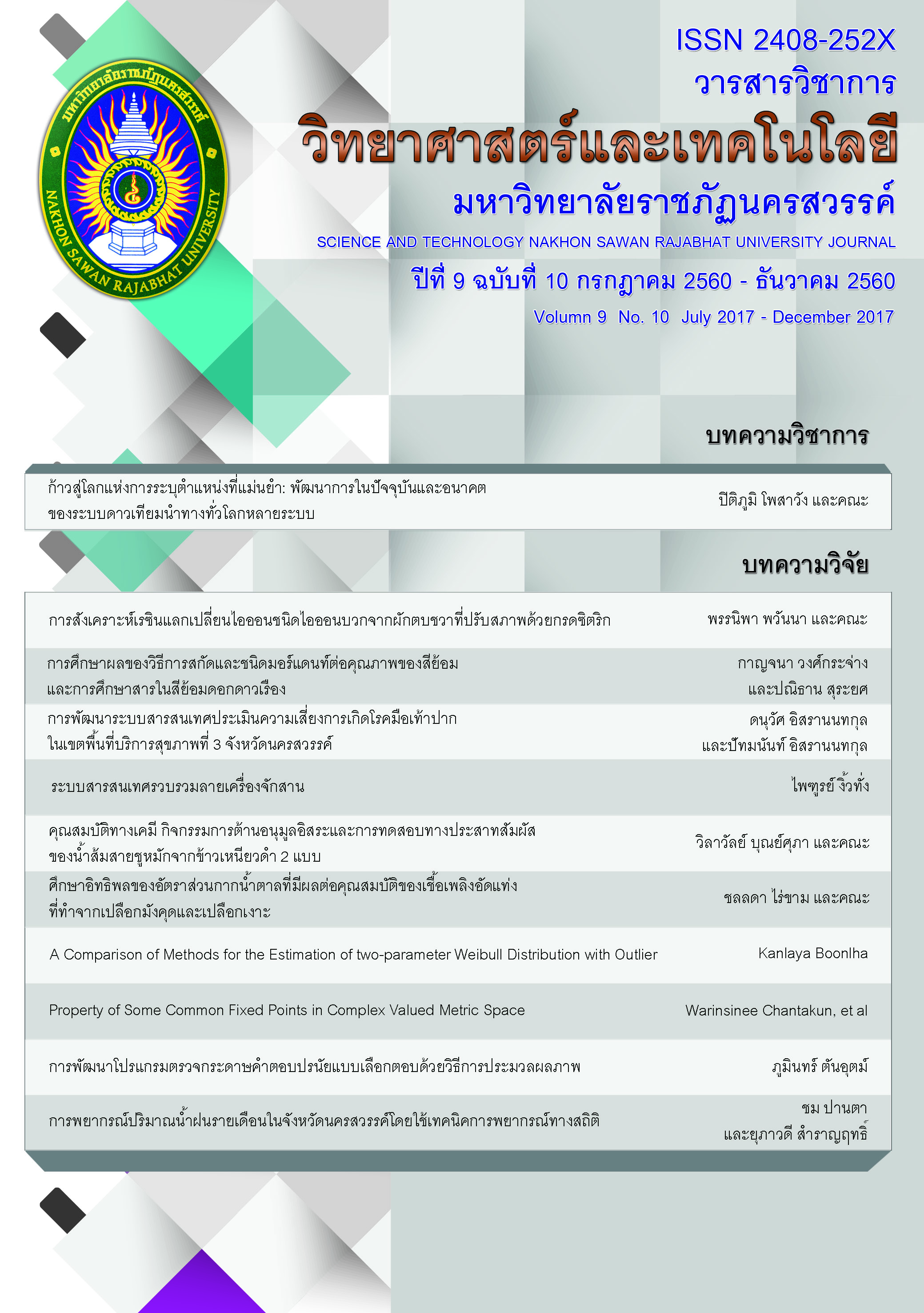ก้าวสู่โลกแห่งการระบุตำแหน่งที่แม่นยำ: พัฒนาการในปัจจุบันและอนาคตของระบบดาวเทียมนำทางทั่วโลกหลายระบบ
Main Article Content
Abstract
ระบบดาวเทียมนำทางทั่วโลกหลายระบบ (Multi-global navigation satellite systems/ Multi-GNSS) คือ ระบบที่สามารถคำนวณตำแหน่ง ความเร็วและเวลาโดยรับสัญญาณจากระบบดาวเทียมนำทางหลายระบบซึ่งถูกนำมาพัฒนาประยุกต์ใช้ได้หลายร้อยแอพพลิเคชั่นที่สามารถนำมาใช้ประโยชน์ได้ในชีวิตประจำวันและสังคมทันสมัยสำหรับเพิ่มความปลอดภัย ปัจจุบันเทคโนโลยีของระบบดาวเทียมนำทางทั่วโลกหลายระบบได้ถูกปรับปรุงให้ดีขึ้นทั้งด้านความพร้อมใช้งานและความแม่นยำในการระบุตำแหน่งด้วยการรวมกันของระบบดาวเทียมนำทางทั่วโลกหลายระบบ ดังนั้น นักวิจัยสามารถนำระบบดาวเทียมนำทางทั่วโลกหลายระบบมาพัฒนาแอพพลิเคชั่นอย่างหลากหลายที่ต้องการระบบการระบุตำแหน่งด้วยความแม่นยำสูง สำหรับบทความนี้ ผู้วิจัยได้ทบทวนวรรณกรรมที่เกี่ยวข้องกับการศึกษาสภาพปัจจุบันของระบบดาวเทียมนำทางทั่วโลกหลายระบบ ประกอบด้วย 1) การจัดการและการบรรเทาภัยพิบัติ 2) การบริการการระบุตำแหน่ง 3) การเกษตรความแม่นยำสูง 4) การควบคุม แนะนำเครื่องจักรและการสำรวจ และ 5) ระบบการขนส่งอัจฉริยะ ในอนาคตข้างหน้าเทคโนโลยีของระบบดาวเทียมนำทางทั่วโลกหลายระบบและเครื่องรับสัญญาณจะมีการพัฒนาขีดความสามารถให้มีความแม่นยำสูงมากขึ้นเรื่อย ๆ ส่งผลให้นักวิจัยสามารถนำข้อมูลการระบุตำแหน่งที่แม่นยำมาใช้ประโยชน์เพื่อสร้างสรรค์และพัฒนาแอพพลิเคชั่นได้อย่างหลากหลายโดยเฉพาะอย่างยิ่งในงานที่ไม่สามารถประยุกต์ใช้ระบบดาวเทียมนำทางระบุตำแหน่งได้ในสมัยก่อน
Article Details
References
Aini, I. N., Aimrun, W., Amin, M. S. M., Ezrin, M. H., and Shafri, H. Z. (2014). Auto Guided Oil Palm Planter by using multi-GNSS. In IOP Conference Series: Earth and Environmental Science.
Bakuła, M. (2012). An approach to reliable rapid static GNSS surveying. Survey Review, 44(327), 265-271.
Cabinet Office Government of Japan. (2017). Overview of the Quasi-Zenith Satellite System (QZSS). Retrieved March 18, 2017, from http://qzss.go.jp/en/overview/services/ sv01_what.html
Chen, K., Zamora, N., Babeyko, A. Y., Li, X., and Ge, M. (2015). Precise positioning of BDS, BDS/GPS: implications for Tsunami early warning in South China Sea. Remote Sensing, 7(12), 15955-15968.
China Satellite Navigation Office. (2015, July). Updates on BeiDou Navigation Satellite System. Retrieved March 18, 2017, from http://www.ignss.org/LinkClick.aspx?fileticket=lBZaLK2ge98%3D&tabid=151&mid=565
Clausen, P., Gilliéron, P. Y., Perakis, H., Gikas, V., and Spyropoulou, I. (2015). Positioning accuracy of vehicle trajectories for road applications. In Proceedings of the 22nd ITS World Congress (No. EPFL-CONF-213568).
Conde, L., Chelim, R., and Nunes, U. (2015, September). Collaborative Vehicle Self-Localization Using Multi-GNSS Receivers and V2V/V2I Communications. In Intelligent Transportation Systems (ITSC), 2015 IEEE 18th International Conference. pp. 2525-2532. IEEE.
Drenjanac, D., Tomic, S., Agüera, J., and Perez-Ruiz, M. (2014). Wi-fi and satellite-based location techniques for intelligent agricultural machinery controlled by a human operator. Sensors, 14(10): 19767-19784.
European GNSS Agency. (2015, March). GNSS Market Report Issue 4. Retrieved March 18, 2017, from http://www.gsa.europa.eu/system/files/reports/GNSS-Market-Report-2015-issue4_0.pdf
European Space Agency. (2016, September). Galileo a constellation of 30 navigation satellites. Retrieved March 18, 2017, from http://www.esa.int/Our_Activities/Navigation/Galileo/Galileo_a_constellation_of_navigation_satellites
Garnero, G., and Caresio, G. (2014). Use of Ashtech MobileMapper GNSS system in forestry applications. International Journal of Innovative Science, Engineering & Technology, 1(7): 479-484.
Guo, C., Guo, W., Cao, G., and Dong, H. (2015). A lane-level LBS system for vehicle network with high-precision BDS/GPS positioning. Computational intelligence and neuroscience, 2015, 7.
Hsu, L. T., Gu, Y., and Kamijo, S. (2016). 3D building model-based pedestrian positioning method using GPS/GLONASS/QZSS and its reliability calculation. GPS solutions, 20(3), 413-428.
Indian Space Research Organisation. (2017). Satellite Navigation. 2016. Retrieved March 18, 2017, from http://www.isro.gov.in/spacecraft/satellite-navigation
Information and Analysis Center for Positioning Navigation and Timing. (2017). Current and Future Satellite Generations. Retrieved January 20, 2017, from http://www.gps.gov/systems/gps/space/#generations
Iwaizumi, D., Ishida, T., Iino, S., Kohtake, N., and Buist, P. (2014, September). GNSS-based emergency message service: Lessons learned and future prospects. In Advanced Satellite Multimedia Systems Conference and the 13th Signal Processing for Space Communications Workshop (ASMS/SPSC), 2014 7th (pp. 276-283). IEEE.
Japan Aerospace Exploration Agency. (2015). Multi GNSS Asia Annual Report 2015. Retrieved March 18, 2017, from http://www.multignss.asia/pdf/MGA_Annual_Report_2015A.pdf
Kabir, M. S. N., Song, M. Z., Sung, N. S., Chung, S. O., Kim, Y. J., Noguchi, N., and Hong, S. J. (2016). Performance comparison of single and multi-GNSS receivers under agricultural fields in Korea. Engineering in Agriculture, Environment and Food, 9(1), 27-35.
Kriechbaumer, T., Blackburn, K., Breckon, T. P., Hamilton, O., and Rivas Casado, M. (2015). Quantitative evaluation of stereo visual odometry for autonomous vessel localisation in inland waterway sensing applications. Sensors, 15(12), 31869-31887.
Langer, M., and Trommer, G. F. (2014, May). Multi GNSS constellation deeply coupled GNSS/INS integration for automotive application using a software defined GNSS receiver. In Position, Location and Navigation Symposium-PLANS 2014, 2014 IEEE/ION. pp. 1105-1112. IEEE.
Li, X., Dick, G., Lu, C., Ge, M., Nilsson, T., Ning, T., and Schuh, H. (2015). Multi-GNSS meteorology: real-time retrieving of atmospheric water vapor from BeiDou, Galileo, GLONASS, and GPS observations. IEEE Transactions on Geoscience and Remote Sensing, 53(12), 6385-6393.
Musulin, I., Brčić, D., and Kos, S. (2014, January). A study of smartphone satellite positioning performance at sea using GPS and GLONASS systems. In ISEP 2014: ITS for Seamless and Energy Smart Transport.
Nuksit, N., Raksit, T., Sunhapos, C., and Sanya, K. (2014). Driver Behavior Detection Based On Multi-Gnss Precise Point Positioning Technology. In Applied Mechanics And Materials, (619).
Oksanen, T. (2015). Accuracy and performance experiences of four wheel steered autonomous agricultural tractor in sowing operation. In Field and Service Robotics. pp. 425-438. Springer International Publishing.
Pérez-Ruiz, M., Gonzalez-de-Santos, P., Ribeiro, A., Fernandez-Quintanilla, C., Peruzzi, A., Vieri, M., and Agüera, J. (2015). Highlights and preliminary results for autonomous crop protection. Computers and Electronics in Agriculture, 110: 150-161.
Rohm, W., Yuan, Y., Biadeglgne, B., Zhang, K., & Le Marshall, J. (2014). Ground-based GNSS ZTD/IWV estimation system for numerical weather prediction in challenging weather conditions. Atmospheric Research, 138, 414-426.
Siebert, S., and Teizer, J. (2014). Mobile 3D mapping for surveying earthwork projects using an Unmanned Aerial Vehicle (UAV) system. Automation in Construction, 41, 1-14.
Someswar, G. Manoj, T. P. S. C. Rao, and Dhanunjaya Rao Chigurukota. (2013). Global navigation satellite systems and their applications. International. Journal of Software and Web Sciences 3: 17-23.
The International GNSS Service. (2017). IGS Network. Retrieved March 18, 2017, from http://igs.org/network
The National Coordination Office for Space-Based Positioning Navigation and Timing. (2017). Glonass constellation status. Retrieved March 18, 2017, from https://www.glonass-iac.ru/en/GLONASS/
Vellidis, G., Ortiz, B., Beasley, J., Hill, R., Henry, H., and Brannen, H. (2014). Reducing digging losses by using automated steering to plant and invert peanuts. Agronomy, 4(3), 337-348.
Wrona, M., Nykiel, G., Figurski, M., and Szolucha, M. (2014, January). Multi-GNSS measurement system for Structural Health Monitoring applications. In Environmental Engineering. Proceedings of the International Conference on Environmental Engineering. ICEE (Vol. 9, p. 1). Vilnius Gediminas Technical University, Department of Construction Economics & Property.
Yu, K. (2015). Tsunami-wave parameter estimation using GNSS-based sea surface height measurement. IEEE Transactions on Geoscience and Remote Sensing, 53(5), 2603-2611.


